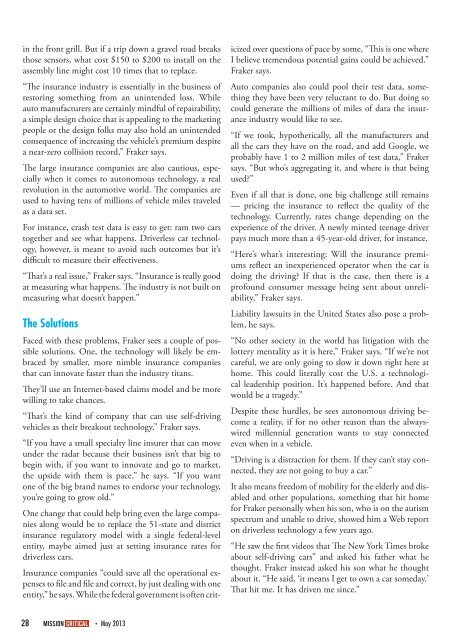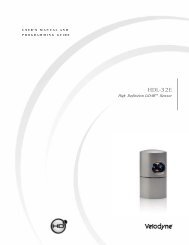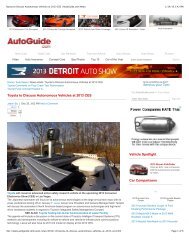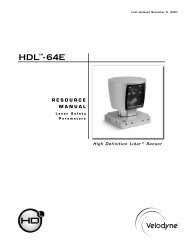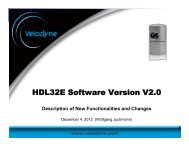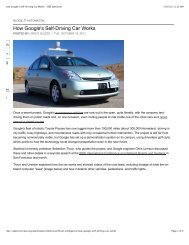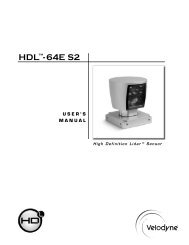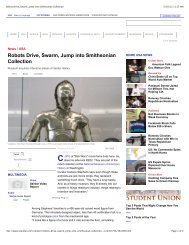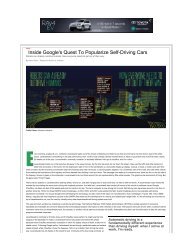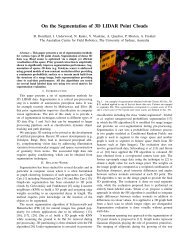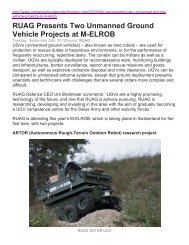Driverless Vehicles Make Inroads in Military - Velodyne Lidar
Driverless Vehicles Make Inroads in Military - Velodyne Lidar
Driverless Vehicles Make Inroads in Military - Velodyne Lidar
You also want an ePaper? Increase the reach of your titles
YUMPU automatically turns print PDFs into web optimized ePapers that Google loves.
<strong>in</strong> the front grill. But if a trip down a gravel road breaks<br />
those sensors, what cost $150 to $200 to <strong>in</strong>stall on the<br />
assembly l<strong>in</strong>e might cost 10 times that to replace.<br />
“The <strong>in</strong>surance <strong>in</strong>dustry is essentially <strong>in</strong> the bus<strong>in</strong>ess of<br />
restor<strong>in</strong>g someth<strong>in</strong>g from an un<strong>in</strong>tended loss. While<br />
auto manufacturers are certa<strong>in</strong>ly m<strong>in</strong>dful of repairability,<br />
a simple design choice that is appeal<strong>in</strong>g to the market<strong>in</strong>g<br />
people or the design folks may also hold an un<strong>in</strong>tended<br />
consequence of <strong>in</strong>creas<strong>in</strong>g the vehicle’s premium despite<br />
a near-zero collision record,” Fraker says.<br />
The large <strong>in</strong>surance companies are also cautious, especially<br />
when it comes to autonomous technology, a real<br />
revolution <strong>in</strong> the automotive world. The companies are<br />
used to hav<strong>in</strong>g tens of millions of vehicle miles traveled<br />
as a data set.<br />
For <strong>in</strong>stance, crash test data is easy to get: ram two cars<br />
together and see what happens. <strong>Driverless</strong> car technology,<br />
however, is meant to avoid such outcomes but it’s<br />
difficult to measure their effectiveness.<br />
“That’s a real issue,” Fraker says. “Insurance is really good<br />
at measur<strong>in</strong>g what happens. The <strong>in</strong>dustry is not built on<br />
measur<strong>in</strong>g what doesn’t happen.”<br />
The Solutions<br />
Faced with these problems, Fraker sees a couple of possible<br />
solutions. One, the technology will likely be embraced<br />
by smaller, more nimble <strong>in</strong>surance companies<br />
that can <strong>in</strong>novate faster than the <strong>in</strong>dustry titans.<br />
They’ll use an Internet-based claims model and be more<br />
will<strong>in</strong>g to take chances.<br />
“That’s the k<strong>in</strong>d of company that can use self-driv<strong>in</strong>g<br />
vehicles as their breakout technology,” Fraker says.<br />
“If you have a small specialty l<strong>in</strong>e <strong>in</strong>surer that can move<br />
under the radar because their bus<strong>in</strong>ess isn’t that big to<br />
beg<strong>in</strong> with, if you want to <strong>in</strong>novate and go to market,<br />
the upside with them is pace,” he says. “If you want<br />
one of the big brand names to endorse your technology,<br />
you’re go<strong>in</strong>g to grow old.”<br />
One change that could help br<strong>in</strong>g even the large companies<br />
along would be to replace the 51-state and district<br />
<strong>in</strong>surance regulatory model with a s<strong>in</strong>gle federal-level<br />
entity, maybe aimed just at sett<strong>in</strong>g <strong>in</strong>surance rates for<br />
driverless cars.<br />
Insurance companies “could save all the operational expenses<br />
to file and file and correct, by just deal<strong>in</strong>g with one<br />
entity,” he says. While the federal government is often criticized<br />
over questions of pace by some, “This is one where<br />
I believe tremendous potential ga<strong>in</strong>s could be achieved.”<br />
Fraker says.<br />
Auto companies also could pool their test data, someth<strong>in</strong>g<br />
they have been very reluctant to do. But do<strong>in</strong>g so<br />
could generate the millions of miles of data the <strong>in</strong>surance<br />
<strong>in</strong>dustry would like to see.<br />
“If we took, hypothetically, all the manufacturers and<br />
all the cars they have on the road, and add Google, we<br />
probably have 1 to 2 million miles of test data,” Fraker<br />
says. “But who’s aggregat<strong>in</strong>g it, and where is that be<strong>in</strong>g<br />
used”<br />
Even if all that is done, one big challenge still rema<strong>in</strong>s<br />
— pric<strong>in</strong>g the <strong>in</strong>surance to reflect the quality of the<br />
technology. Currently, rates change depend<strong>in</strong>g on the<br />
experience of the driver. A newly m<strong>in</strong>ted teenage driver<br />
pays much more than a 45-year-old driver, for <strong>in</strong>stance.<br />
“Here’s what’s <strong>in</strong>terest<strong>in</strong>g: Will the <strong>in</strong>surance premiums<br />
reflect an <strong>in</strong>experienced operator when the car is<br />
do<strong>in</strong>g the driv<strong>in</strong>g If that is the case, then there is a<br />
profound consumer message be<strong>in</strong>g sent about unreliability,”<br />
Fraker says.<br />
Liability lawsuits <strong>in</strong> the United States also pose a problem,<br />
he says.<br />
“No other society <strong>in</strong> the world has litigation with the<br />
lottery mentality as it is here,” Fraker says. “If we’re not<br />
careful, we are only go<strong>in</strong>g to slow it down right here at<br />
home. This could literally cost the U.S. a technological<br />
leadership position. It’s happened before. And that<br />
would be a tragedy.”<br />
Despite these hurdles, he sees autonomous driv<strong>in</strong>g become<br />
a reality, if for no other reason than the alwayswired<br />
millennial generation wants to stay connected<br />
even when <strong>in</strong> a vehicle.<br />
“Driv<strong>in</strong>g is a distraction for them. If they can’t stay connected,<br />
they are not go<strong>in</strong>g to buy a car.”<br />
It also means freedom of mobility for the elderly and disabled<br />
and other populations, someth<strong>in</strong>g that hit home<br />
for Fraker personally when his son, who is on the autism<br />
spectrum and unable to drive, showed him a Web report<br />
on driverless technology a few years ago.<br />
“He saw the first videos that The New York Times broke<br />
about self-driv<strong>in</strong>g cars” and asked his father what he<br />
thought. Fraker <strong>in</strong>stead asked his son what he thought<br />
about it. “He said, ‘it means I get to own a car someday.’<br />
That hit me. It has driven me s<strong>in</strong>ce.”<br />
28 MISSION CRITICAL • May 2013


